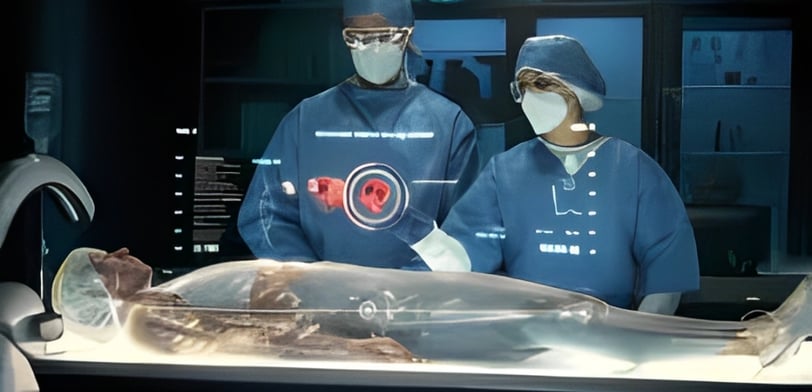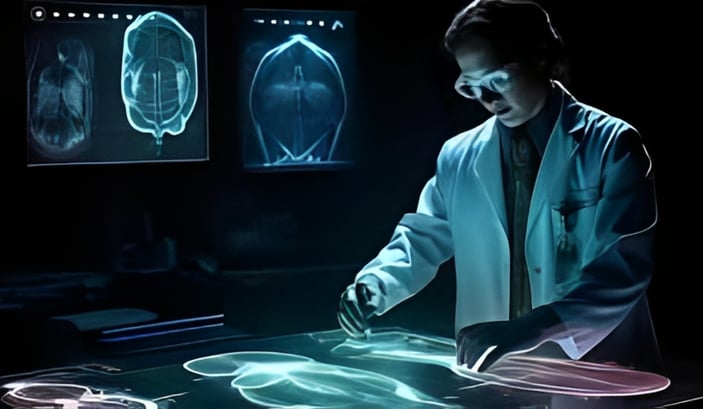The Role of AI in Enhancing X-Ray Image Interpretation
Artificial Intelligence (AI) is transforming multiple sectors, and healthcare is no exception. Among its most promising applications is the enhancement of diagnostic imaging, particularly in X-ray image interpretation. X-rays are a crucial diagnostic tool in the medical field, used to examine bones, detect lung diseases, identify infections, and more. However, interpreting X-ray images requires high levels of precision, expertise, and time, making AI a game changer in this space. In this blog, we'll explore how AI is enhancing X-ray image interpretation, improving diagnostic accuracy, reducing workload, and ultimately saving lives.
3/22/20254 min read


How AI Is Revolutionizing X-Ray Image Interpretation
AI in medical imaging typically involves machine learning (ML) algorithms that have been trained on vast amounts of imaging data to identify patterns and anomalies. These algorithms can analyze X-ray images faster than human radiologists, offering several advantages, from improving diagnostic accuracy to speeding up the entire process. Let's break down how AI is enhancing X-ray image interpretation:
1. Improved Accuracy and Consistency
One of the biggest challenges in interpreting X-ray images is maintaining high accuracy and consistency across different radiologists and imaging centers. AI models, especially deep learning algorithms, can be trained to recognize patterns in images with extreme precision. These models are designed to spot even the slightest abnormalities that may be missed by the human eye.
For example, AI can help in detecting early signs of diseases such as pneumonia, tuberculosis, fractures, or even cancer, providing a second set of "eyes" to ensure that nothing is overlooked. By processing thousands of images and learning from them, AI algorithms improve over time, leading to increasingly accurate predictions and diagnoses.
2. Faster Diagnosis and Increased Efficiency
AI-driven tools can process X-ray images in a fraction of the time it takes a human radiologist. This rapid image analysis can lead to faster diagnoses, which is especially critical in emergency situations where time is of the essence. In busy healthcare settings, such as emergency departments or clinics with high patient volumes, AI can help reduce the workload of radiologists, allowing them to focus on more complex cases.
For example, AI can rapidly identify fractures in bone X-rays or detect signs of pneumonia in chest X-rays, quickly flagging these images for further review. This allows healthcare professionals to intervene more quickly and improve patient outcomes.
3. Reducing Human Error
Despite the expertise of radiologists, human error is always a possibility. Factors such as fatigue, distractions, or simply overlooking a small detail can lead to misinterpretation. AI systems, on the other hand, do not suffer from these human limitations. They can consistently analyze images without experiencing the mental fatigue that affects humans after hours of work.
AI tools can act as a safety net, offering a second opinion to ensure that critical issues aren’t missed. This not only helps in preventing diagnostic errors but also boosts the overall reliability of medical imaging.
4. Enhancing Image Quality
AI is also being used to enhance the quality of X-ray images themselves. Image enhancement algorithms can improve the clarity and sharpness of X-rays, helping radiologists detect subtle abnormalities that might be obscured by noise or poor image quality. This is especially useful in low-dose X-ray systems, where the image quality can sometimes be compromised to minimize radiation exposure.
AI-powered image enhancement tools can automatically correct for issues like contrast, resolution, and even reduce motion artifacts, ultimately resulting in clearer and more accurate images.
5. AI in Workflow Automation
In addition to analyzing images, AI can help streamline the entire diagnostic workflow. AI systems can categorize and organize X-ray images, flagging the ones that need urgent attention and reducing the amount of time radiologists spend sifting through images. Workflow optimization tools powered by AI can prioritize cases based on severity, ensuring that patients with critical conditions are treated first.
Moreover, AI can also automate the generation of preliminary reports for radiologists, freeing them from repetitive tasks and allowing them to focus on more complex analyses. This efficiency boost is especially beneficial in large healthcare settings where a high volume of X-ray images need to be processed regularly.
6. AI-Assisted Decision Support
AI is not meant to replace human radiologists but rather to assist them in making more informed decisions. With the assistance of AI, radiologists can receive more accurate data, trend analysis, and detailed information to support their diagnosis. AI systems can suggest potential diagnoses based on image patterns and historical data, allowing radiologists to confirm or reject these suggestions with a higher level of confidence.
AI can also integrate patient history, medical records, and other relevant data, providing a more comprehensive view of the patient’s health and helping radiologists make better decisions.
Real-World Applications of AI in X-Ray Imaging
Several healthcare systems and imaging companies are already using AI to enhance X-ray image interpretation. Some of the most notable applications include:
Chest X-rays and Pneumonia Detection: AI models, such as those developed by companies like Zebra Medical Vision and Google Health, have been trained to identify pneumonia in chest X-rays. These tools can detect the presence of infection with remarkable accuracy, often outperforming human radiologists.
Fracture Detection: AI algorithms have been developed to automatically detect bone fractures, which is particularly useful for orthopedic practices and emergency departments. These AI tools can quickly identify fractures in X-ray images, even in challenging cases like small or hairline fractures.
Breast Cancer Detection: AI is also making waves in breast cancer detection. Algorithms designed to analyze mammograms can identify potential signs of breast cancer, such as masses or microcalcifications, that may not be easily visible to the human eye.
The Future of AI in X-Ray Image Interpretation
As AI technology continues to evolve, its role in X-ray image interpretation will become even more significant. Advances in deep learning and neural networks will enable AI models to analyze more complex imaging modalities and integrate additional data sources, providing a more comprehensive and accurate diagnosis.
In the future, we can expect AI to:
Offer more sophisticated tools for multi-modal image analysis, combining X-ray with CT scans, MRIs, and ultrasound images for a holistic view of patient health.
Improve real-time collaboration by enabling radiologists and AI systems to work seamlessly together, providing instant insights during patient consultations.
Increase accessibility in underserved regions, where AI-powered systems could help healthcare professionals with limited resources or training interpret X-ray images accurately.


Reference Website Links:
Zebra Medical Vision
Website: https://www.zebra-med.com/
Google Health AI
Radiology Society of North America (RSNA)
National Institute of Biomedical Imaging and Bioengineering (NIBIB)
The Journal of Digital Imaging
Innovative
Contact Us
Service
xraybazar.com
© 2024. All rights reserved.
Address- Rajasthan, India
Gmail Id- xraybazaroffcial.com
Important Links
